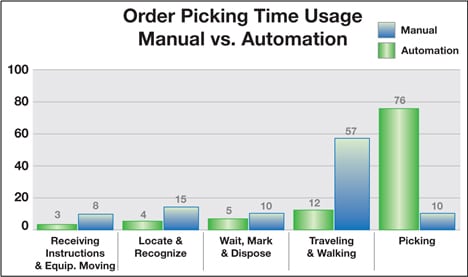
Omnichannel commerce puts a premium on reducing the cost of order fulfillment while at the same time speeding up the fulfillment process. This is most efficiently accomplished by automating the order picking, packing and shipping operations. In conventional storage and retrieval operations, pickers can spend up to 90% of their time walking aisles searching and locating items. As a result, only 10% of their time is spent picking orders.
With automated storage and retrieval systems, this process reversed, with employees spending more time fulfilling orders. This is particularly important in omnichannel commerce operations where the goal of full integration of store and online sales requires added efficiency in order picking. Because of their added efficiency, automated systems may only require about 2/3 of the workforce typically required to fulfill orders in a conventional rack and shelving system. Productivity typically improves by up to 2.5 times. With automation in place, it is often not necessary to add labor (or in a much smaller scale) to meet ever changing seasonal demand.
With the addition of pick to light indicators, information displays and bar code scanning devices, picking and putting accuracy can improve to 99.99% while throughput can improve up to 500%+.
[ALSO: Optimizing Omnichannel Order Picking and Fulfillment Operations]
There is a wide range of choices when considering an order picking automated system. They include, but are not limited to, horizontal carousels, Vertical Lift Modules (VLMs), ASRS, conveyors, A-frames and Automated Guided Vehicles (AGVs), or some combination of any of these technologies.
Automated packing and shipping systems are an efficient way to reduce costs and improve delivery accuracy. There are systems available that automatically build the “right size” box for any order, reducing corrugated storage costs thereby improving customer satisfaction. Other systems automatically print and insert documents, such as manifests, invoices, instructions and return labels, into boxes. Other systems automatically weigh, label and seal cartons for shipping. These systems can be made even more efficient with the installation of buffering and sortation systems to help meter the flow of orders for processing.
One way to narrow the choices and facilitate the selection of appropriate automated systems is to create a decision matrix. Build the matrix by listing the function or zone with appropriate technologies on the left. Across the top, list all criteria’s that are important. Identify which criteria are important to meeting order fulfillment goals and business objectives such as labor, throughput, space savings, improved accuracy, ROI, ergonomics, and flexibility. Evaluate these criteria vs. qualitative factors as not important, important, very important, and must have.
At this point, it’s best to call in an automation expert to recommend the best solution for your specific needs and requirements. Most automated systems can be expanded and/or modified to meet changing needs, making them very cost effective. The return on investment in these systems is fast, in some cases 12 months or less.
Saving Space Saves Time and Money
Industry surveys indicate that some retailers use store locations to fulfill online orders. Many retailers also use store locations as a pick up point to fulfill online orders. Others have consolidated distribution and fulfillment operations into fewer facilities.
Automated storage and retrieval systems (ASRS), including vertical lift modules (VLMs), vertical carousels, crane and aisle plus shuttle technologies take advantage of unused overhead space to recover 60% to 85% of the floor space typically required by shelving and drawer systems.
[ALSO: Understanding Omnichannel Inventory Dynamics]
Floor space recovered with the installation of automated storage and retrieval systems can often be re-allocated from cost-associated functions of inventory to value-increasing operations. Improved space utilization can also extend the useful life of existing facilities, eliminating the need for expensive square footage expansion in order to meet growth requirements. Small unit footprint makes vertical systems especially valuable for point-of-use storage. Because of their vertical design, these systems can be used to link multiple operations located on different floors, for example, further reducing the amount of space required for storage and retrieval activities while also improving workflow.
By reducing the amount of space required for storage and retrieval operations, companies can construct smaller, more energy efficient buildings, shrinking the construction footprint by up to 15% in some cases, conserving natural resources and reducing maintenance costs. This improved space utilization also helps reduce energy costs, which, in turn, reduces overall costs.
Omnichannel and ecommerce represents a growth opportunity for all retailers. In order to take advantage of this valuable opportunity, and meet the challenges that it presents to customer service needs and requirements, sellers need to look at an integrated systems approach to inventory control and management with the focus on inventory visibility, reducing pick costs and getting the most value from the space they have available.
Ed Romaine is CMO – VP Marketing of Integrated Systems Design (ISD). https://plus.google.com/+EdRomaine